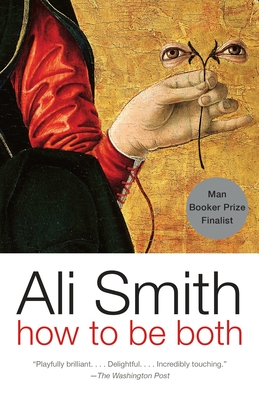How To Be Both, Ali Smith, Pantheon Books, 2014, 315 pp
This is the second of the three books I bought while on vacation. I had heard of it and of the author plus the cover spoke to me. Reading it for me was so special and took me away on flights of imagination, being about two female artists separated by five centuries. The book might not create such a reaction in every reader due to the somewhat experimental writing, unless you like stories about unusual women, art, and strange connections. It is the literary version of books like The Last Painting of Sara de Vos.
George, whose given name is Georgia, is a British teen in the present day, the child of a child of the 1960s. She has just lost her annoying mother who died unexpectedly. I lost an annoying mother. I know that conundrum of grieving for someone so close to and yet so different from oneself. In fact, the first sentence of the book is: "Consider this moral conundrum for a moment, George's mother says to George, who's sitting in the front passenger seat." George didn't know what a moral conundrum was at the time but now she is finding them everywhere.
After following George through 150 pages of grieving for and reminiscing about her mother, we are introduced to the first person voice of a female Renaissance painter, Francesco del Cossa, who is passing as a male in Italy. She turns out to be the creator of the frescoes George's mother took her and her brother to see a few months before the mother's death. Said painter was famous for demanding more money for producing better art.
We learn the story of Francesca's life, her parents, her mentor and supporter, her lover, how she became Francesco, and her tragic end. It is a wondrous tale of a strong, talented, and fearless individual.
Later in the book Francesca's disembodied spirit begins to follow George in her 21st century life.
As a plot it makes little sense but as a meditation on creativity, love of many kinds and second chances, it made a beautiful and dreamlike sense. I was carried along in a sort of blissful state and I loved every page.
(How To Be Both is available in paperback by order from Once Upon A Time Bookstore.)

Earlier this year I read Smith's Autumn and thought it was brilliant. It, too, was, in part, about art and its influence on our lives. I look forward to reading her other works, including this one. It sounds fascinating.
ReplyDeleteI want to read Autumn next and the rest of that trilogy. She is certainly a talented writer.
DeleteHmm..."a literary version of Sara de Vos" sounds good to me. I love the cover, by the way; it is a strange mixture of a Renaissance painting and a Dali's one.
ReplyDeleteYes, that cover! It truly does represent the book.
DeleteI had heard of this book but had no idea what it was about until reading your review. I don't always like experimental writing so I'm not sure if I will read this one, but it sounds interesting and unusual. I'm glad you loved it.
ReplyDeleteThe historical part about the Renaissance painter is great art history from the POV of a painter of the times. The experimental aspect is not all that weird, not James Joyce or anything, but it is stream of consciousness sometimes and there is a ghost!
DeleteI like your answer from above. It makes me not as hesitant to try out Smith's books. She definitely sounds creative!
ReplyDeleteAfter Helen's comment I realized that "experimental" is a kind of scary word when applied to writing. Is it as scary when applied to music?
DeleteExperimental is a word that usually means it isn't suited to everyone's taste. ;-)
DeleteIt gives me great pleasure that my blog followers are chatting with each other!
DeleteWow, this book sounds really good. I'll be adding it my eved growing reading wishlist. Nice review!
ReplyDeleteThanks! I am pleased that all commenting here are favorable toward the book, because I sure liked it.
DeleteI need to try it!
ReplyDelete